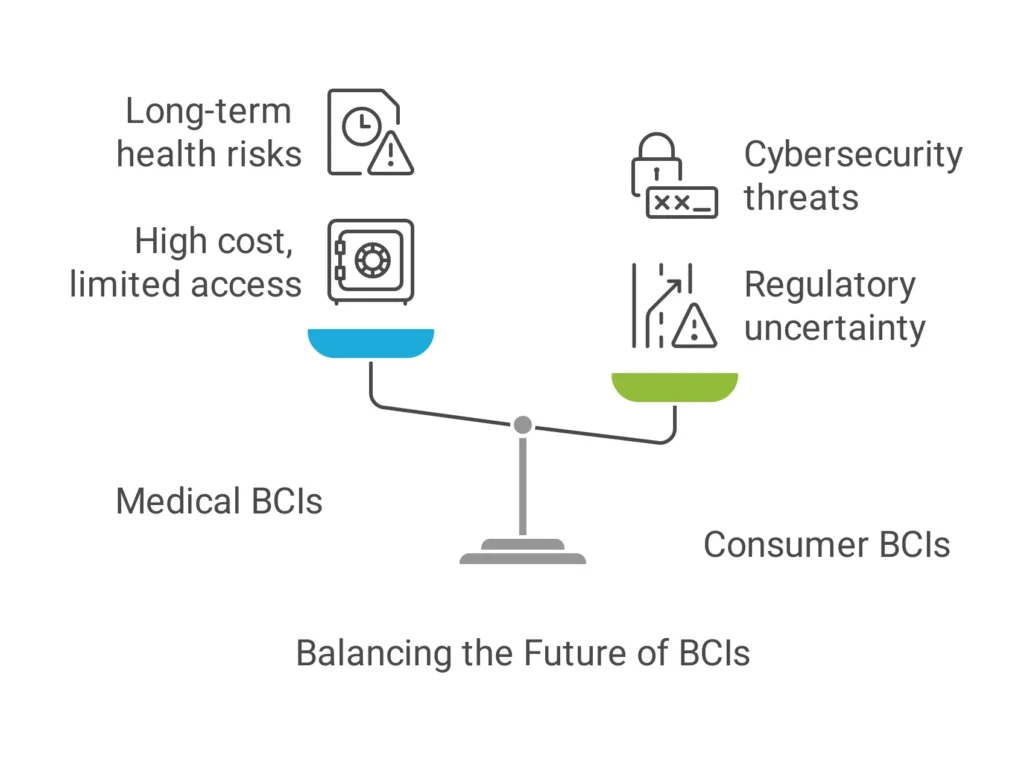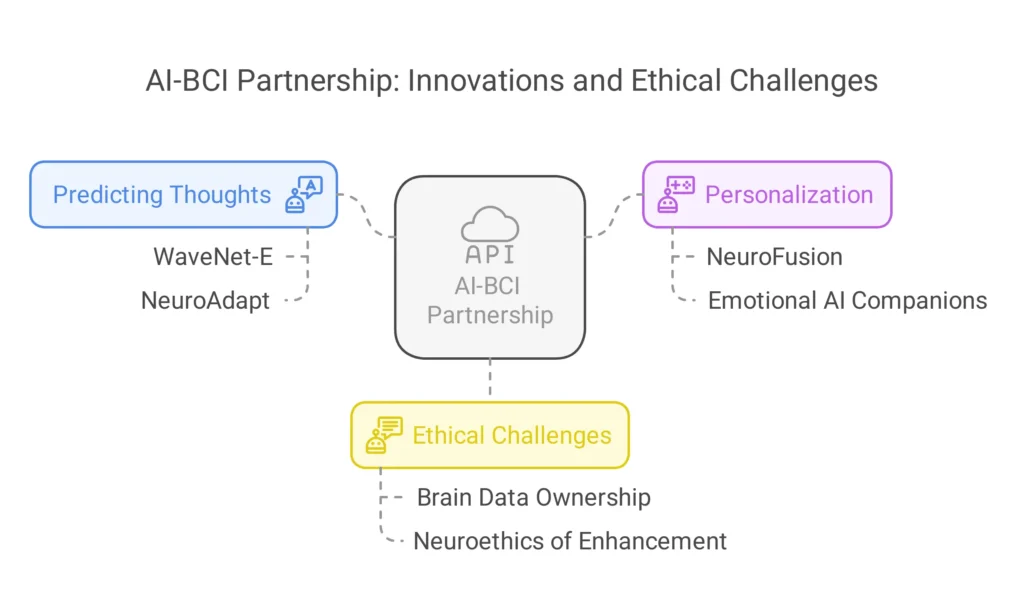Imagine controlling a computer with your thoughts or restoring movement to paralyzed limbs using a tiny implant. This isn’t science fiction—it’s the rapidly approaching future of brain-computer interfaces (BCIs). Over the next decade, BCIs will reshape healthcare, redefine human-machine interaction, and spark important ethical debates. As a developer with five years of experience in AI and neuro technology, I’ve seen firsthand how these innovations are accelerating. Let’s explore what’s coming next.

How BCIs Are Changing Healthcare
Non-Invasive BCIs: Better, Faster, and More Accessible
The days of sticky gel electrodes and bulky headgear are fading. New dry electrode technology, like graphene-based sensors, now offers near-perfect signal quality without scalp preparation. Devices such as OpenBCI’s Galea and Muse’s next-gen headbands use 256-channel arrays packed into designs resembling everyday headphones. These wearables can monitor brain activity for up to 72 hours, making them ideal for tracking conditions like epilepsy or sleep disorders.
Motion artifacts—a longtime headache for developers—are also being solved. The DSI-24 system uses carbon nanotube meshes to keep impedance stable, even during intense workouts. This reliability is why the wearable EEG market is growing at 14.2% annually, with applications expanding into workplace safety and education.
Key Advancements in Non-Invasive BCIs
| Technology | Breakthrough | Impact |
| Dry Electrodes | 98.7% signal fidelity, no scalp prep | Continuous monitoring for chronic conditions |
| AI Signal Processing | 92.3% accuracy in decoding motor imagery | Faster rehabilitation tools |
| Motion Artifact Fixes | <5µV impedance variance during exercise | Reliable data in real-world settings |
Medical Miracles: From Paralysis to Seizure Control
BCIs are already transforming lives. The Vivistim Paired VNS System helps stroke survivors regain arm movement three times faster than traditional therapy. By syncing vagus nerve stimulation with motor cortex activity, it “rewires” damaged neural pathways. Similarly, researchers at the University of Pittsburgh restored finger movements in quadriplegic patients using implantable arrays that translate faint brain signals into robotic commands.

For epilepsy, acoustic BCIs are a game-changer. These systems detect pre-seizure brain waves and zap the vagus nerve with ultrasound, cutting seizures by 89% in drug-resistant cases. In mental health, devices like the STIM-DBS implant adjust stimulation in real-time to treat depression, achieving 64% remission rates.
The Rise of Implantable BCIs: Beyond Medical Needs
Neuralink and the Push for Mainstream Implants
Elon Musk’s Neuralink might dominate headlines, but other players are making waves too. Blackrock Neurotech enables locked-in patients to type 8.6 words per minute via motor cortex implants. Meanwhile, Synchron’s Stentrode lets users control emails through electrodes placed in blood vessels—no open-brain surgery required.
These devices are becoming safer and more powerful. For example, Paradromics’ Connexus records from 16,384 channels simultaneously, enough to drive robotic limbs with 22 degrees of freedom. As a developer, I’m amazed by how quickly decoding resolution is improving. What took years to achieve a decade ago now happens in months.

Ethical Dilemmas: Who Gets Enhanced?
With great power comes great responsibility. Elective implants for memory enhancement could cost $20,000, raising concerns about inequality. Regulatory gaps also exist: consumer devices like Humm’s neurostimulation patches operate in a gray area, offering “focus boosts” without FDA approval.
Long-term risks are another worry. A 2024 study found glial scarring in 23% of decade-old implants, though no functional decline yet. More urgent? Cybersecurity. Hackers recently hijacked EEG headsets via Bluetooth, proving neural data isn’t immune to breaches.
BCIs in Everyday Life: Gaming, Work, and Beyond
Gaming and VR: Your Brain as the Controller
Gaming drives 42% of consumer BCI investment. Valve’s Index Neuro Kit tracks 14 emotional states to adapt gameplay in titles like Half-Life: Neuro. Meta’s Project Cambria uses blood oxygenation patterns for avatar control, achieving 150ms latency—faster than blinking.
But it’s not all fun. The esports industry banned “neural doping” devices after they boosted reaction times by 18%. Detecting these tools is tough since they mimic natural brain waves, posing a fairness challenge.
Workplace Productivity: Monitoring Minds at Work
Companies are testing BCIs to combat fatigue. Amazon warehouses use Emotiv’s Insight 2 to pause assembly lines when workers’ theta waves spike. Startups like Flow Neuroscience sell headsets that blend EEG and tDCS to sharpen focus, claiming 31% productivity gains.
While promising, this raises red flags. Unions argue such monitoring feels invasive, and the EU is already arbitrating cases about worker rights.
The AI-BCI Partnership: Smarter Together

Predicting Thoughts Before They Happen
AI is turbocharging BCIs. DeepMind’s WaveNet-E decodes silent speech from EEG data with 95% accuracy, enabling “subvocal communication.” MIT’s NeuroAdapt goes further, predicting intentions 800ms before conscious awareness. Imagine wheelchairs that move before you decide to push—this tech is already in trials.
Personalization Through Machine Learning
Systems like NeuroFusion self-optimize using reinforcement learning, improving monthly. Emotional AI companions adjust interactions based on real-time amygdala activity, making them eerily intuitive. As a developer, integrating these adaptive models requires balancing accuracy with computational efficiency—a challenge I face daily.
Navigating the Ethical Minefield
Who Owns Your Brain Data?
In 2024, the GDPR classified neural data as “biometric essence,” mandating strict protection. Yet breaches persist: 23TB of EEG recordings were stolen last year, exposing “brain fingerprints.” Solutions like differential privacy add noise to datasets, but the arms race continues.
The Neuroethics of Enhancement
The WHO’s 2025 Neuroethics White Paper stresses four pillars: agency, authenticity, cognitive liberty, and pluralism. Yet access disparities remain—78% of BCI users have advanced degrees, mostly in wealthy regions. Projects like OpenBCI’s GNU Neuro aim to democratize access with $200 headsets, but scaling is slow.
Military and Industry: The Double-Edged Sword
Soldiers with Superhuman Senses
DARPA’s Cortical Modem implants project targeting retinas directly into vision, slashing threat response times to 50ms. More controversially, Project Mindforge alters PTSD memories via hippocampal stimulation. While effective, these applications blur lines between therapy and enhancement.
Safer Factories, But at What Cost?
Siemens’ NeuroSafe cuts factory accidents by 43% using EEG to detect fatigue. However, workers argue it’s coercive. The EU is now weighing regulations to prevent misuse.
Looking Ahead: The 2035 Vision
By 2035, BCIs will evolve from tools to partners. Hybrid systems merging implants with cloud AI could enable real-time knowledge sharing, blurring human and machine intelligence. Early adopters report “extended cognition,” though we’re still learning the psychological impacts. Direct brain-to-brain communication and quantum neural processors hint at a future where consciousness itself becomes programmable.
Final Thoughts
The next decade of BCIs will be thrilling and fraught with challenges. From curing diseases to redefining privacy, these technologies demand careful stewardship. As both a developer and a curious observer, I’m optimistic—but only if we prioritize ethics alongside innovation.
What’s Next?
- Stay updated with OpenBCI’s open-source projects.
- Join forums like NeurotechX to discuss BCI ethics.
- Experiment with affordable tools like Muse headsets to see the tech in action.
The future of BCIs isn’t just about tech—it’s about shaping a world where technology serves humanity, not the other way around.
Pingback: Brain-Computer Interfaces: Restoring Mobility for Paralyzed Patients - 2025 Cybersecurity And Threat Intelligence
Pingback: The Evolution of Non-Invasive Brain-Computer Interfaces in 2025 - 2025 Cybersecurity And Threat Intelligence
Pingback: Why the Brains of a Computer Define Tech Innovation - Exploring the Future of Brain-Computer Interfaces & AI
I have recently started a web site, the info you offer on this site has helped me tremendously. Thanks for all of your time & work. “There is a time for many words, and there is also a time for sleep.” by Homer.
I’d have to examine with you here. Which is not one thing I usually do! I take pleasure in reading a post that may make folks think. Additionally, thanks for permitting me to comment!